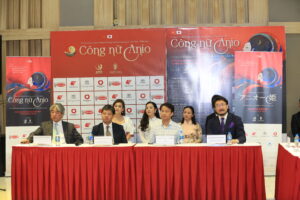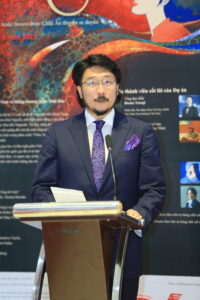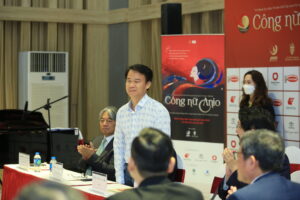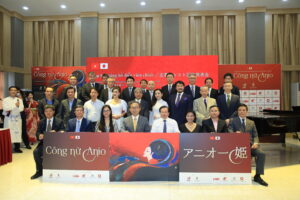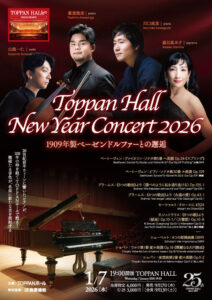PickUp (2022/6/15) |Main Cast Presentation for opera “Princess Anio” |KANOH, Haruka
Main Cast Presentation for opera “Princess Anio” – Commemorating the 50th Anniversary of the Establishment of Diplomatic Relations between Japan and Vietnam
日越外交関係樹立 50 周年記念・新作オペラ「アニオー姫」主要キャスト記者発表会
Họp báo công bố diễn viên chính vở opera “Công nữ Anio” – Kỷ niệm 50 năm thiết lập quan hệ ngoại giao Việt Nam và Nhật Bản
2022/6/03 Rehearsal studio of Vietnam National Symphony Orchestra (Hanoi)
2022年6月3日 ベトナム国立交響楽団リハーサルスタジオ(ハノイ)
Ngày 3 Tháng 6 Năm 2022 Hội trường của Dàn nhạc Giao hưởng Việt Nam (Hà Nội)
Text by KANOH, Haruka
Photos by the Princess Anio Executive Committee
On 3 June 2022, a press conference was held at the rehearsal studio of the Vietnam National Symphony Orchestra in Hanoi, the capital of Vietnam, to announce the main casts of the new opera “Princess Anio”. It is now being jointly produced by the two countries to mark the 50th anniversary of the establishment of diplomatic relations between Japan and Vietnam in 2023. The press conference was also broadcasted via Zoom, and participants from Japan were able to attend.
It has been about six months since the last press conference. This included the announcement of the four main cast members (double cast) and the performance of an aria, which showed that the project is progressing steadily. I would like to report some parts of the conference from my viewpoint as below.
*The entire length of the press conference can be viewed on the official Youtube channel of the Princess Anio Executive Committee. For more information on the project, please see the official website and my article ‘Culture Building Vietnam-Japan Relations: On the New Opera “Princess Anio”‘ (only in Japanese and Vietnamese).
** For English readers, I would like to introduce the outline of this project by quoting the press release in December 2021 at the bottom.
Japanese director, playwright, and lyricist Oyama Daisuke, who was visiting Vietnam, announced the main casts in the middle of the conference. The two singers who were selected to play the role of Araki Sotaro (tenor) were Kobori Yusuke and Yamamoto Kohei. Both participated in this conference via video message, where Mr Kobori expressed his enthusiasm for learning about the life of Sotaro, a merchant of Shuinsen (shogunate-licensed trading ships from the end of the 16th century to the beginning of the 17th century), and at the same time deepening his role. Mr Yamamoto, on the other hand, expressed his pleasure of playing Sotaro, who is related to Nagasaki and Vietnam, two places with which he has close ties. Princess Anio (soprano) will be played by Dao To Loan and Bui Thi Trang from the Vietnam National Opera Ballet. They appeared in all-white costumes and performed “Aria Dan bau” (dan bau: Vietnamese monochord musical instrument) from Act III of the opera Princess Anio. The video can be viewed here.
This aria, according to Mr Oyama, is “an aria that the Princess Anio sings with her thoughts going to her hometown, Hoi An in Vietnam, from the distant foreign country Japan after she came to Nagasaki as the bride of Sotaro. Its melody contains “the essence of folk songs that resonate in the hearts of Vietnamese people”. Unfortunately, the acoustics through a computer screen and earphones via Zoom were not so good. Yet, the melancholy but bright melody, composed by composer Tran Manh Hung and sung by the two singers with operatic and powerful voices, seemed to appeal to the audience directly. I look forward to listening to it as one scene from the opera at the theatre.
During the question-and-answer session, Vietnamese media attending the conference, including Vietnam Plus Newspaper, Vietnam News Newspaper, Vietnam Women’s Newspaper and Vietnam Television, asked some questions. Mr Oyama and the orchestra’s music director and chief conductor Honna Tetsuji (project representative) answered the questions and revealed some aspects of the work and the stage. One of these was the languages used in the opera. Basically, according to Mr Oyama, Vietnamese will be used for conversations among Vietnamese people and Japanese for conversations among Japanese people, but there might be some scenes where, for example, Araki Sotaro sings in Vietnamese in Acts I and II, which are set in Vietnam. How the languages are used in each scene and how the singers deal with them will be one of the highlights of this opera. Of course, the opera will be subtitled in Japanese, Vietnamese and, if possible, English.
Regarding performance venues other than Hanoi, Mr Honna revealed his desire to perform the opera in Ho Chi Minh City, Da Nang, Hoi An, Hue and other parts of Vietnam as well as to realise the Japan premiere not too long after the world premiere in Hanoi. While the Japan tour is highly anticipated, we can also imagine a trip to Vietnam to enjoy the story of Sotaro and Princess Anio at the Hanoi Opera House, which was built during the French colonial period.
Questions were also asked from Japan on the Zoom chat. In contrast to the Vietnamese media, which mainly asked the Japanese members, the Japanese side showed great interest in the Vietnamese artists. When asked about their enthusiasm for playing Princess Anio, both Ms Bui and Ms Dao expressed their will to fulfil the role. Ms Dao also said in Japanese: “I love Japanese culture and people. I hope that Vietnam and Japan will always be good friends”.
Mr Tran shared his experience in his composing process. Before the performance of “Aria Dan bau”, Mr Oyama said that “the melodies of Vietnamese folk songs have some similarities with Japanese folk songs, so they might remind not only Vietnamese people but also Japanese of some nostalgic scenes of their homeland”. Mr Tran, in his reply to journalists, also mentioned the similarities between the modes of Vietnamese and Japanese folk songs and traditional music. Moreover, he mentioned his findings that Japanese music has some similarities not only with the music of the Kinh (the majority ethnic group in Vietnam) but also with that of ethnic minorities in Vietnam. How will Tran’s findings emerge in his music? How will it sound to our ears? We look forward to the entirety of the opera.
The project is probably still in its infancy. According to Mr Honna, his next big challenge is casting the remaining roles. Mr Oyama said that he will work on finishing the libretto, which he started writing around May last year, and brushing it up to match the music composed by Mr Tran.
In his speech, Mr Takio Yamada, the Ambassador Extraordinary and Plenipotentiary of the Embassy of Japan in Vietnam, and also the Honorary Advisor to the project, mentioned, that when Japanese Prime Minister Kishida Fumio had visited Vietnam in May 2022, he and President Nguyen Xuan Phuc shared the desire to make this opera a great one. The premiere of the opera is now about one year and three months away. The opera “Princess Anio” will continue to involve more and more people, organisations and even countries in its creation. I will continue to observe this project closely.
**On the new opera “Princess Anio” (Quoted from the press release in December 2021 by the Princess Anio Executive Committee )
In commemoration of the 50th Anniversary of the Establishment of Diplomatic Relations between Japan and Vietnam in 2023, the Vietnam National Symphony Orchestra and the Princess Anio Executive Committee (Brain Group, Yamaha Music Vietnam Company Limited, and the Association of International Exchange) have announced the production and premiere of a new opera titled Princess Anio.
This project aims both to promote exchange and friendship between Japan and Vietnam as well as to propel their respective cultures of music forward. The world premiere will take place at the Hanoi Opera House in September 2023.
The story of the opera revolves around the romance between Araki Sotaro, a merchant from Nagasaki, Japan, and Princess Anio from Hoi An, Vietnam, during the trading era of the Shuinsen in the early 17th century. Japan and Vietnam have historically had a strong, trusting, and frank relationship.
The production of this opera aims to create a lasting symbol of the further deepening of relations between the two countries.
This project welcomes Yamada Takio, Japanese Ambassador in Vietnam, as its Honorary Advisor, and is supported by the Embassy of Japan in Vietnam and many organizations related to Japan and Vietnam.
(2022/6/15)
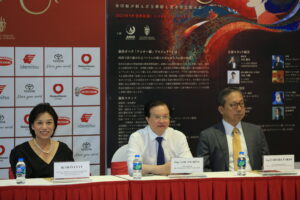
(left) Production Advisor Tran Ly Ly – Acting Director of the Department of Performing Arts, the Ministry of Culture, Sports, and Tourism
(middle) Guest Ta Quang Dong – Deputy Minister of the Ministry of Culture, Sports and Tourism
(right) Honorary Advisor to the project Takio Yamada – Ambassador Extraordinary and Plenipotentiary of the Embassy of Japan in Vietnam
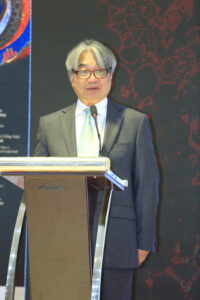
Representative Mr Honna Tetsuji – Vietnam National Symphony Orchestra Music Director and Principal Conductor
—————————————————
KANOH, Haruka
Postdoctoral Fellow, Graduate School of Social Sciences, Hitotsubashi University. PhD (Social Sciences). Major in area studies (Vietnam), musical culture studies, global studies, etc. She stayed in Hanoi when she was a graduate student for her research. She has conducted research in a multi-disciplinary way on the relationship between art and politics, especially through “classical music.” Her postdoctoral dissertation is “Opera in Socialist Vietnam” (2021).
